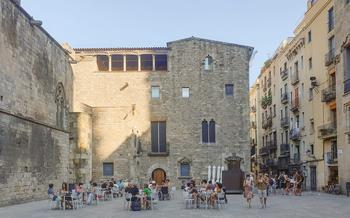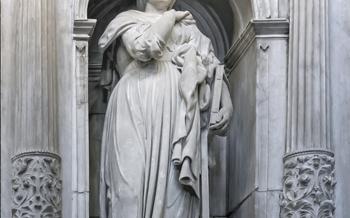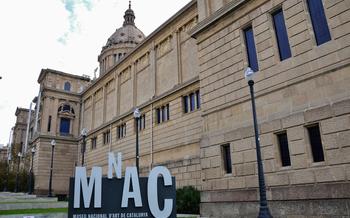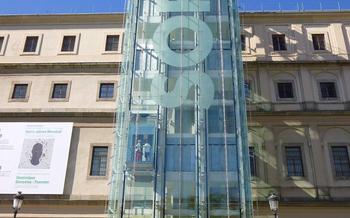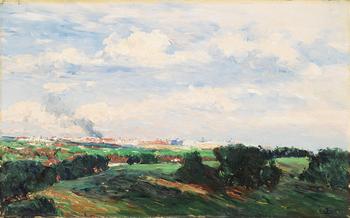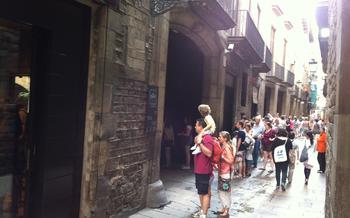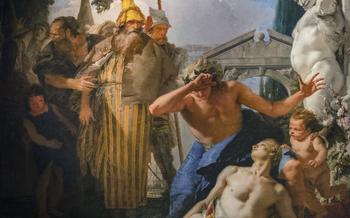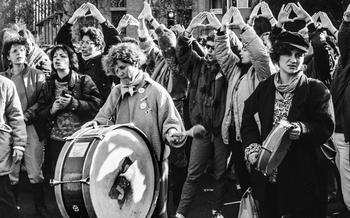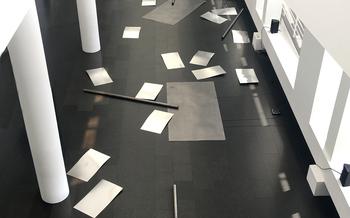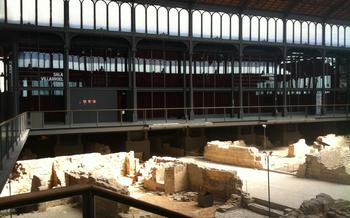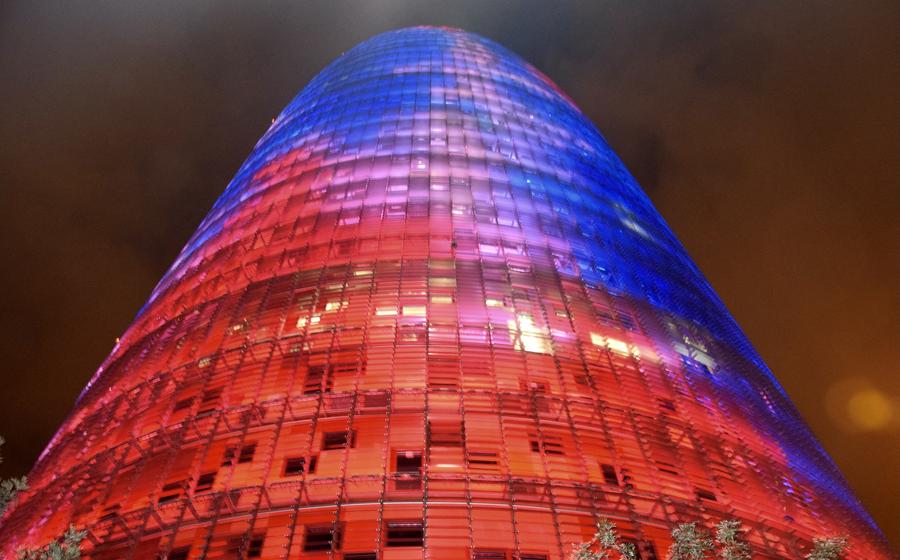
Museu Picasso Els 4 Gats
- History and Significance: A Journey through Art and Culture
- Exploring the Collection: Masterpieces and Hidden Gems
- The Early Years: Picasso's Formative Period in Barcelona
- Interactive Experiences and Educational Programs
- The Museum's Architectural Heritage: A Blend of History and Modernity
- Immerse Yourself in Picasso's World: Thematic Tours and Workshops
- Unveiling Picasso's Creative Process: Behind-the-Scenes Tours
- Picasso's Legacy in Barcelona: Beyond the Museum
- The Museum's Bookstore and Gift Shop: Unique Souvenirs and Publications
- Accessibility and Inclusivity: Ensuring a Welcoming Experience for All
- The Museum's Conservation Efforts: Preserving Picasso's Legacy
- Insider Tip: Hidden Gems and Local Recommendations
History and Significance: A Journey through Art and Culture
The Museu Picasso Els 4 Gats holds a significant place in Barcelona's cultural history, serving as both a repository of Pablo Picasso's early works and a testament to the city's vibrant art scene during the late 19th and early 20th centuries. Founded in 1963, the museum is housed within the Els 4 Gats cafe, a renowned meeting place for intellectuals, artists, and bohemians of the era. Here, Picasso exhibited his early creations, including the famous "Las Meninas" and "La Vie," which showcased his unique style and artistic vision. The museum's collection also features a range of ceramics, drawings, and paintings from Picasso's Blue Period, offering a glimpse into the formative years of one of the most influential artists of all time.
Conveniently located in the heart of Barcelona's Gothic Quarter, the Museu Picasso Els 4 Gats is easily accessible by metro, bus, or on foot. The museum's building itself is a work of art, boasting a blend of Gothic and Modernista architectural elements. Its charming interior, adorned with intricate stained-glass windows and mosaic floors, creates a unique ambiance that transports visitors back in time. The museum's location within the historic Els 4 Gats cafe further enhances the experience, offering a tangible connection to the cultural ferment of Barcelona's past.
Exploring the Collection: Masterpieces and Hidden Gems
As you embark on your journey through the Museu Picasso Els 4 Gats, prepare to be captivated by a diverse collection that reflects the evolution of one of the most influential artists in history. Among the highlights, you will find exceptional pieces from Picasso's iconic Blue Period, characterized by somber hues and introspective subjects. These works, such as "The Old Guitarist" and "La Vie," showcase Picasso's mastery of expressing emotions through his brushstrokes. The museum also boasts an impressive array of ceramics created by Picasso during his later years, revealing his versatility and experimentation with different mediums.
Delving deeper into the collection, you will discover lesser-known gems that shed light on Picasso's artistic development. For instance, the early works from his Barcelona period, such as "Portrait of Josep Cardona," showcase his early influences and the gradual emergence of his unique style. Temporary exhibitions and special events further enrich the museum experience, allowing visitors to explore specific themes or periods in Picasso's prolific career.
Through this journey into Picasso's artistic world, you will gain a profound understanding of his artistic evolution, his experimentation with different mediums, and the profound impact he has had on the art world.
The Early Years: Picasso's Formative Period in Barcelona
In 1895, a young Pablo Picasso arrived in Barcelona, a city that would profoundly shape his artistic journey. Immersed in the vibrant cultural scene of Catalonia, Picasso found inspiration and influence in the works of local artists, the city's architecture, and the bustling streets.
During this early period, Picasso experimented with various styles and techniques, from realism to symbolism. Key works from this time include "La Vie," a poignant portrayal of an elderly woman, and "Las Meninas," a reinterpretation of Velázquez's famous painting. These works showcased Picasso's exceptional talent and foreshadowed the groundbreaking artistic innovations that would come to define his career.
Barcelona's rich cultural environment played a pivotal role in Picasso's development. He frequented the city's museums, galleries, and theaters, absorbing influences from a wide range of artistic movements. The city's lively intellectual and bohemian circles provided a stimulating atmosphere for creative exchange, fostering Picasso's growth as an artist and thinker.
It was in Barcelona that Picasso began to develop his unique artistic vision and style. His early works displayed a mastery of technique and a willingness to push boundaries, paving the way for his subsequent groundbreaking contributions to modern art.
Interactive Experiences and Educational Programs
The Museu Picasso Els 4 Gats offers a range of educational programs and workshops tailored to visitors of all ages, fostering a deeper understanding and appreciation of Picasso's work. Interactive exhibits and multimedia presentations complement the museum experience, providing engaging and immersive ways to explore the artist's creative journey.
Guided tours led by knowledgeable docents offer in-depth insights into the collection, shedding light on the significance and context of Picasso's masterpieces. Audio guides are available in multiple languages, allowing visitors to navigate the museum at their own pace while gaining valuable information about the exhibits.
Families with children can participate in hands-on workshops designed to spark creativity and encourage artistic expression. These workshops provide a unique opportunity for young learners to engage with Picasso's art through interactive activities and hands-on projects.
Through these educational programs and interactive experiences, the Museu Picasso Els 4 Gats strives to make art accessible and enjoyable for everyone, fostering a lifelong appreciation for Picasso's genius and the vibrant cultural heritage of Barcelona.
The Museum's Architectural Heritage: A Blend of History and Modernity
The Museu Picasso Els 4 Gats is housed in a stunning building that holds historical significance in Barcelona's cultural landscape. Originally constructed in the late 19th century, the building was once home to the legendary Els 4 Gats cafe, a renowned meeting place for artists, writers, and intellectuals of the time. In 1963, the building underwent a meticulous restoration that transformed it into the museum dedicated to Pablo Picasso's early life and work.
The museum's architectural features blend historical charm with modern elements, creating a captivating ambiance that enhances the visitor experience. The building's facade, adorned with intricate details and vibrant colors, hints at its rich history. Upon entering the museum, visitors are greeted by a spacious courtyard, which serves as a tranquil oasis amidst the bustling city. The courtyard features a striking fountain and lush greenery, providing a serene setting for contemplation and reflection on Picasso's artistic journey.
Throughout the museum, visitors can appreciate the careful preservation of original architectural elements, such as the intricate tile work, vaulted ceilings, and decorative moldings. These details add an air of authenticity and transport visitors back in time to the era when Picasso frequented Els 4 Gats. The museum's design seamlessly integrates modern elements that complement the historical features, such as glass panels and sleek display cases, creating a harmonious balance between the past and present.
The restoration efforts undertaken by the museum have ensured that the building's original character and charm are preserved while adapting it to its new purpose as a cultural institution. This careful consideration for the building's heritage contributes to the unique atmosphere of the Museu Picasso Els 4 Gats, making it a must-visit destination for those seeking a deeper understanding of Picasso's early years and the vibrant cultural scene of Barcelona.
Immerse Yourself in Picasso's World: Thematic Tours and Workshops
The Museu Picasso Els 4 Gats offers a range of thematic tours and workshops that provide visitors with an opportunity to delve deeper into the life and work of Pablo Picasso. These special programs are designed to explore specific periods, styles, or themes in Picasso's artistic journey, offering a unique perspective on his creative process and artistic development.
Led by knowledgeable museum educators, these tours and workshops take participants on a captivating journey through Picasso's masterpieces, shedding light on the techniques, influences, and inspirations behind his work. From his early Blue Period to his groundbreaking Cubist paintings, visitors gain insights into the evolution of Picasso's artistic style and his profound impact on the art world.
Hands-on workshops provide a unique opportunity for visitors to engage with Picasso's work in a creative and interactive way. Participants can try their hand at various art techniques inspired by Picasso, such as collage, printmaking, or ceramics, under the guidance of experienced art instructors. These workshops offer a fun and educational way to explore Picasso's artistic legacy and create their own unique artworks.
To ensure an enriching experience, advance booking is recommended for these special programs. Availability may vary, so it's advisable to check the museum's website or inquire at the museum's information desk for more details and scheduling.
Unveiling Picasso's Creative Process: Behind-the-Scenes Tours
The Museu Picasso Els 4 Gats offers exclusive behind-the-scenes tours that provide a unique opportunity to delve into the creative process of one of the most influential artists of the 20th century. These tours take visitors beyond the public galleries, granting them access to the museum's conservation studios and storage facilities, where Picasso's works are meticulously preserved and restored.
During these tours, visitors gain insights into the techniques and materials used by Picasso in his artistic practice. They can observe firsthand the process of restoring and conserving his paintings, learning about the challenges conservators face in preserving these precious works for future generations.
Participants in these exclusive tours have the chance to see works that are not on public display, including unfinished pieces, studies, and sketches that offer a glimpse into Picasso's creative development. They can also learn about the museum's ongoing research projects and conservation initiatives, which contribute to the preservation and understanding of Picasso's legacy.
To ensure a personalized and intimate experience, behind-the-scenes tours are limited in size and require advance booking. They are conducted by experienced museum guides who share their knowledge and expertise, providing visitors with a deeper understanding of Picasso's artistic journey and the museum's role in preserving his works for posterity.
Picasso's Legacy in Barcelona: Beyond the Museum
The Museu Picasso Els 4 Gats offers a comprehensive exploration of Picasso's early life and artistic development in Barcelona, but the city holds many other sites that are intertwined with his legacy. To fully immerse yourself in Picasso's world, venture beyond the museum and discover these hidden gems.
One must-visit location is Picasso's former studio, located at Carrer de la Mercé This intimate space provides a glimpse into the artist's creative process and the environment where he produced some of his most iconic works. The studio has been preserved and is open to the public, allowing visitors to step back in time and experience the atmosphere that inspired Picasso's genius.
Beyond his studio, Barcelona is dotted with other places that hold significance in Picasso's artistic journey. The city's museums and galleries often host exhibitions dedicated to Picasso or featuring works influenced by his style. Keep an eye out for these temporary shows to gain a deeper understanding of Picasso's impact on the art world.
To fully appreciate Picasso's connection to Barcelona, take some time to explore the neighborhoods where he lived and worked. Stroll through the narrow streets of the Gothic Quarter, where Picasso spent his early years, and admire the medieval architecture that served as a backdrop to his artistic evolution.
By following Picasso's footsteps in Barcelona, you will uncover a rich tapestry of history, culture, and art. The city's vibrant energy and diverse cultural offerings provide the perfect context to immerse yourself in the life and work of one of the 20th century's most influential artists.
The Museum's Bookstore and Gift Shop: Unique Souvenirs and Publications
The Museu Picasso Els 4 Gats houses a well-stocked bookstore and gift shop that offers a treasure trove of items for art enthusiasts and Picasso fans. Visitors can browse a wide selection of books, catalogs, and publications dedicated to Picasso's life and work, providing in-depth insights into his artistic journey. These publications range from scholarly texts to beautifully illustrated coffee table books, catering to diverse interests and levels of knowledge.
The gift shop presents a unique opportunity to purchase souvenirs and mementos inspired by Picasso's art. Visitors can find a variety of items, including postcards, posters, prints, and reproductions of some of Picasso's most iconic works. These high-quality reproductions are a wonderful way to bring a piece of Picasso's genius into your own home or to share as gifts with fellow art lovers.
The museum also offers a range of merchandise featuring Picasso's artwork, such as t-shirts, mugs, tote bags, and scarves. These items are not only stylish and functional but also serve as a subtle nod to Picasso's artistic legacy. By purchasing souvenirs and merchandise from the museum's shop, visitors not only take home a tangible reminder of their visit but also support the museum's educational and conservation efforts.
Accessibility and Inclusivity: Ensuring a Welcoming Experience for All
The Museu Picasso Els 4 Gats is committed to providing an accessible and inclusive environment for all visitors. The museum offers a range of facilities and services to ensure that everyone can enjoy and appreciate Picasso's work.
Visitors with disabilities can take advantage of wheelchair ramps, accessible elevators, and adapted restrooms throughout the museum. Audio guides are available in multiple languages, including Spanish, Catalan, English, French, German, Italian, and Russian. Sign language interpretation can be arranged upon request.
The museum also provides a range of educational programs and workshops that are designed to be inclusive and accessible to all. These programs are adapted to meet the needs of visitors with different learning styles and abilities.
The Museu Picasso Els 4 Gats is dedicated to creating a welcoming and inclusive environment for all visitors, regardless of their abilities or disabilities. The museum's staff is trained to assist visitors with disabilities and to ensure that everyone has a positive and enriching experience.
The Museum's Conservation Efforts: Preserving Picasso's Legacy
The Museu Picasso Els 4 Gats is dedicated to preserving and protecting the artistic legacy of Pablo Picasso. The museum's conservation department plays a crucial role in ensuring that Picasso's works remain accessible to future generations. A team of skilled conservators utilizes various techniques and methods to restore and maintain the museum's extensive collection.
The conservators carefully assess each artwork's condition, identifying areas that require attention. They utilize specialized techniques to clean and restore paintings, drawings, and sculptures, ensuring that Picasso's original vision is preserved. The museum also collaborates with other institutions and experts in the field of conservation, exchanging knowledge and best practices.
The conservation department's efforts extend beyond the physical preservation of Picasso's works. They also conduct extensive research to understand the artist's materials and techniques, contributing to a deeper understanding of his creative process. This knowledge informs the museum's conservation strategies and helps ensure that Picasso's legacy remains intact.
By preserving and protecting Picasso's works, the Museu Picasso Els 4 Gats plays a vital role in safeguarding the cultural heritage of Barcelona and the world. Through their dedication and expertise, the conservators ensure that Picasso's masterpieces continue to inspire and captivate audiences for generations to come.
Insider Tip: Hidden Gems and Local Recommendations
As you explore the Museu Picasso Els 4 Gats, keep an eye out for lesser-known works that offer a glimpse into Picasso's artistic development. Look for early sketches, studies, and experimental pieces that reveal the evolution of his style. Don't miss the museum's collection of ceramics, which showcase Picasso's versatility and his exploration of different mediums.
After your visit, take some time to explore the surrounding neighborhood, the vibrant El Born district. Stroll along the charming streets, admire the medieval architecture, and soak in the lively atmosphere. Stop by local cafes and restaurants to savor delicious Catalan cuisine and immerse yourself in the local culture.
For a unique souvenir, visit the museum's gift shop, which offers a carefully curated selection of books, prints, and merchandise inspired by Picasso's art. Support the museum's educational and conservation efforts by purchasing a memento that will remind you of your visit.
To make the most of your experience, consider joining a guided tour or workshop offered by the museum. These programs provide in-depth insights into Picasso's life and work, allowing you to delve deeper into his artistic journey. Advance booking is recommended to secure your spot.
Remember to embrace the local customs and traditions during your visit. Greet people with a friendly "Hola" and be prepared to use basic Spanish phrases, as English may not be widely spoken in some establishments. Respect local customs, such as the traditional siesta time in the afternoon, when many businesses close for a break.
By immersing yourself in the local culture and seeking out hidden gems, you'll gain a richer understanding of Picasso's artistic legacy and the vibrant city that shaped his early career.
